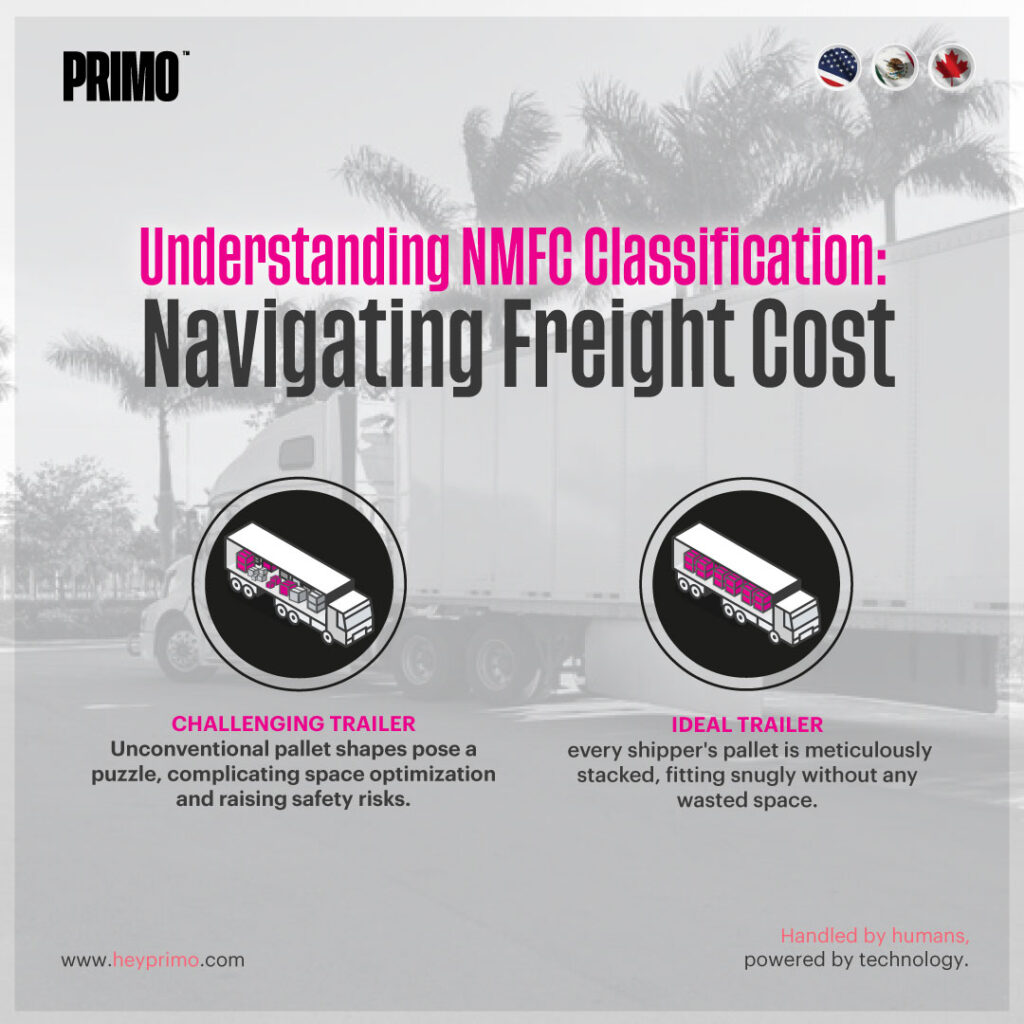
According to National Motor Freight Traffic Association (NMFTA), “The National Motor Freight Classification (NMFC) system is in place to define standard rates for carriers to transport goods. It sorts freight into several categories, which are continuously amended by the National Motor Freight Traffic Association (NMFTA). Through this scale, both fleet managers and recipients of cargo are protected from unfair freight rates, which lets less-than-truckload (LTL) shipments proceed smoothly.
It is important to identify and label the correct freight class when shipping cargo to ensure the transportation process is safe and efficient. If cargo is labeled as the wrong freight class, this can interfere with logistics when loading LTL shipments.”
Let’s take a deeper look at NMFC freight classification and what you need to know about it.
freight class is determined by factors like density, liability, stowability, and handling, impacting shipping costs significantly. This system categorizes goods based on characteristics like density, handling, stowability, and liability, streamlining the shipping process and enabling businesses to predict costs accurately and ensure their cargo is handled appropriately. Of course, the ability to apply LTL classes correctly also directly plays into your ability to consolidate loads and leverage truckload services where possible.
Understanding NMFC codes is critical for anyone involved in shipping. These codes directly influence shipping costs by determining the freight class of a shipment. Strategic use of NMFC codes can lead to substantial savings and more efficient shipping operations. Additionally, implementing strategies for Mexico backhaul optimization can further enhance cost-efficiency and sustainability in freight operations, but again, the freight class will determine the overall viability of such a strategy.
Cargo density directly impacts freight classification. Higher density usually results in a lower freight class, translating to lower shipping costs. For instance, steel machinery parts are dense, occupying less space relative to their weight, leading to efficient use of cargo space and lower shipping rates. Effective freight management strategies can further optimize shipping costs and operational efficiency.
The handling requirements of cargo significantly affect its NMFC classification. Fragile items or those needing special accommodations are classified higher, reflecting the care and risk involved in their transport.
Stowability affects how efficiently cargo can be transported. Items that are easily stowed without needing special considerations tend to fall into lower freight classes.
Conversely, cargo that is difficult to stow due to size, shape, or segregation needs often results in a higher classification. For specialized logistics solutions, particularly in transporting heavy or complex machinery, exploring machinery logistics can provide tailored support and expertise.
The risk associated with transporting cargo plays a significant role in determining its NMFC classification. High-value items or those prone to damage, theft, or spoilage are classified higher.
The commodity type being shipped and resources provided by the NMFTA are crucial for efficient shipping. Commodity characteristics dictate transportation needs and influence NMFC classification.
Proper classification allows for informed decisions on packaging and shipping methods, avoiding unnecessary fees. Shippers should carefully consider:
Partnering with experts in freight classification can simplify shipping logistics and enhance operational efficiency. For instance, third-party logistics providers offer expertise in NMFC classification, providing tailored shipping solutions. They also help in evaluating cargo and advising on best practices to ensure compliance and cost-effectiveness, reducing risk of reclassification down the line too. Plus, there is massive variety in the full list of freight classes, and some items could seem to fit into multiple classes, shown in the table below:
Class | Shipment Example | Weight Per Cubic Foot (Pounds) |
50 | Nuts, bolts and rods | >50 lbs |
55 | Bricks, cement, certain construction materials | 35-50 lbs |
60 | Ceramic tiles, auto accessorials | 30-35 lbs |
65 | Books, bottled liquids | 22.5-30 lbs |
70 | Food items, boxed papers | 15-22.5 lbs |
77.5 | Bathroom fixtures, car accessorials | 13.5-15 lbs |
85 | Pharmaceuticals, bookcases | 12-13.5 lbs |
92.5 | Computers, monitors | 10.5-12 lbs |
100 | Pans, platters, metal, wine cases | 9-10.5 lbs |
110 | Framed artwork, tires | 8-9 lbs |
125 | Small household appliances | 7-8 lbs |
150 | Refrigerators, sheet metal | 6-7 lbs |
175 | Stuffed furniture, dense snacks | 5-6 lbs |
200 | Aluminum parts, mattresses | 4-5 lbs |
250 | Televisions, sofas, potato chips | 3-4 lbs |
300 | Model boats, tables | 2-3 lbs |
400 | Light fixtures, deer antlers | 1-2 lbs |
500 | Ping pong balls, gold dust | <1 lbs |
Clearly, the risk for error and choosing the wrong class is signifiant.
Expert insights into what freight class to assign on every load is critical to simplify the shipping process, allowing businesses to focus on core operations while ensuring logistics efficiency. Mitigating higher costs associated with incorrect or improper freight classification can be a nightmare. Ultimately, it all goes back to the overall feasibility of moving a shipment and how that will impact the perceived level of work in moving the shipment. Gain control over your freight with the right NMFC freight classes by connecting with a PRIMO team member now.